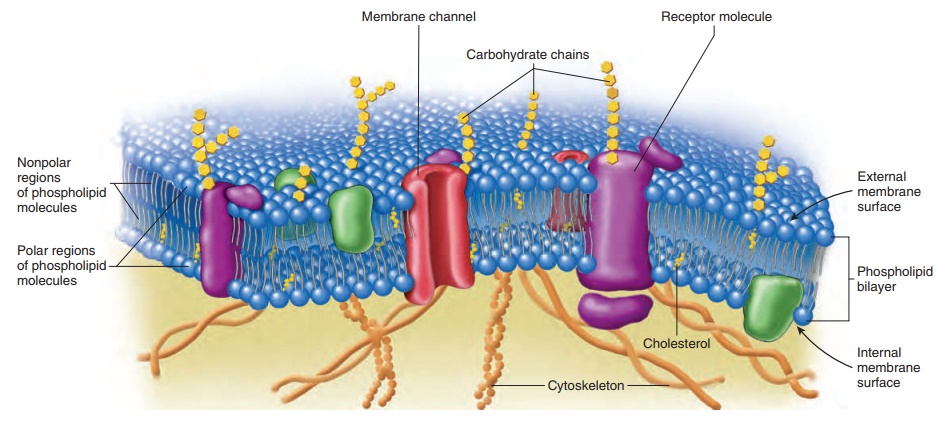Chapter: Essentials of Anatomy and Physiology: Cell Structures and their Functions
Structure of the Cell membrane

Cell membrane
The cell membrane, or plasma (plaz′\ma˘) membrane, is the outermost component of a cell. The cell membrane encloses the cytoplasm and forms the boundary between material inside the cell and material outside it. Substances outside the cell are called extracellular substances, and those inside the cell are called intracellular sub-stances. Besides enclosing the cell, the cell membrane supports the cell contents, acts as a selective barrier that determines what moves into and out of the cell, and plays a role in communication between cells. The major molecules that make up the cell mem-brane are phospholipids and proteins. In addition, the membrane contains other molecules, such as cholesterol and carbohydrates.

Studies of the arrangement of molecules in the cell membrane have given rise to a model of its structure called the fluid-mosaicmodel (figure 3.2). The phospholipids form a double layer ofmolecules. The polar, phosphate-containing ends of the phospho-lipids are hydrophilic (water-loving) and therefore face the extra-cellular and intracellular fluids of the cell. The nonpolar, fatty acid ends of the phospholipids are hydrophobic (water-fearing) and therefore face away from the fluid on either side of the membrane, toward the center of the double layer of phospholipids. The double layer of phospholipids forms a lipid barrier between the inside and outside of the cell.
The double layer of phospholipids has a liquid quality. Cholesterol within the phospholipid membrane gives it added strength and flexibility. Protein molecules “float” among the phospholipid molecules and, in some cases, extend from the inner to the outer surface of the cell membrane. Carbohydrates may be bound to some protein molecules, modifying their functions. The proteins function as membrane channels, carrier molecules, recep-tor molecules, enzymes, or structural supports in the membrane. Membrane channels and carrier molecules are involved with themovement of substances through the cell membrane. Receptormolecules are part of an intercellular communication system thatenables cell recognition and coordination of the activities of cells. For example, a nerve cell can release a chemical messenger that moves to a muscle cell and temporarily binds to a receptor on the muscle cell membrane. The binding acts as a signal that triggers a response, such as contraction of the muscle cell.
Related Topics